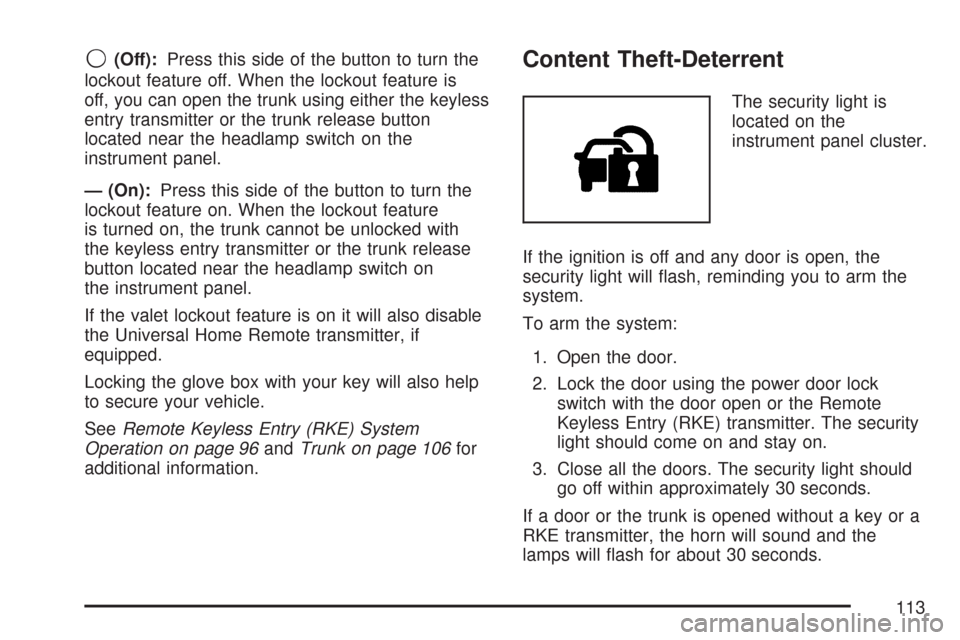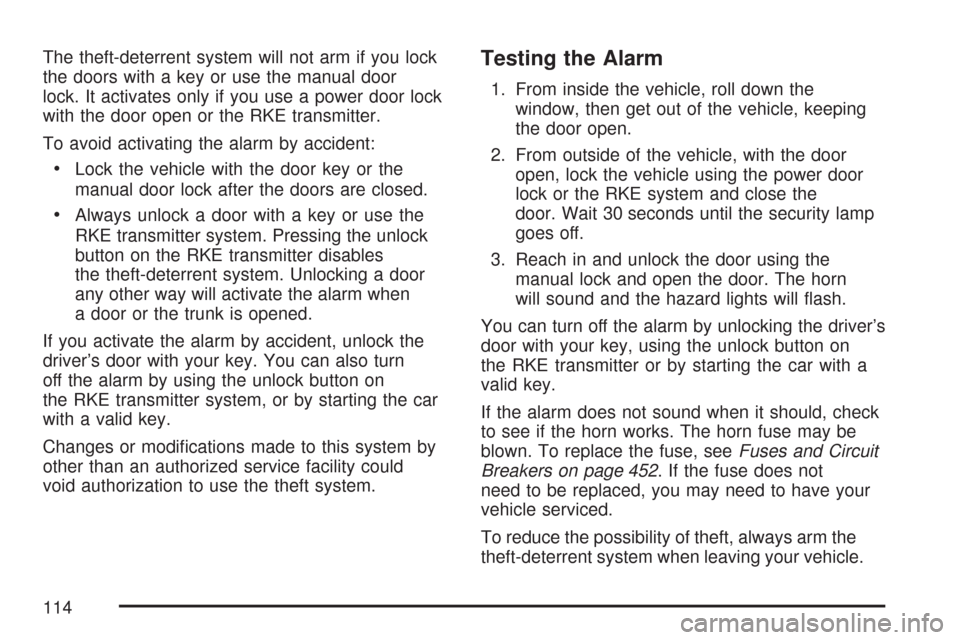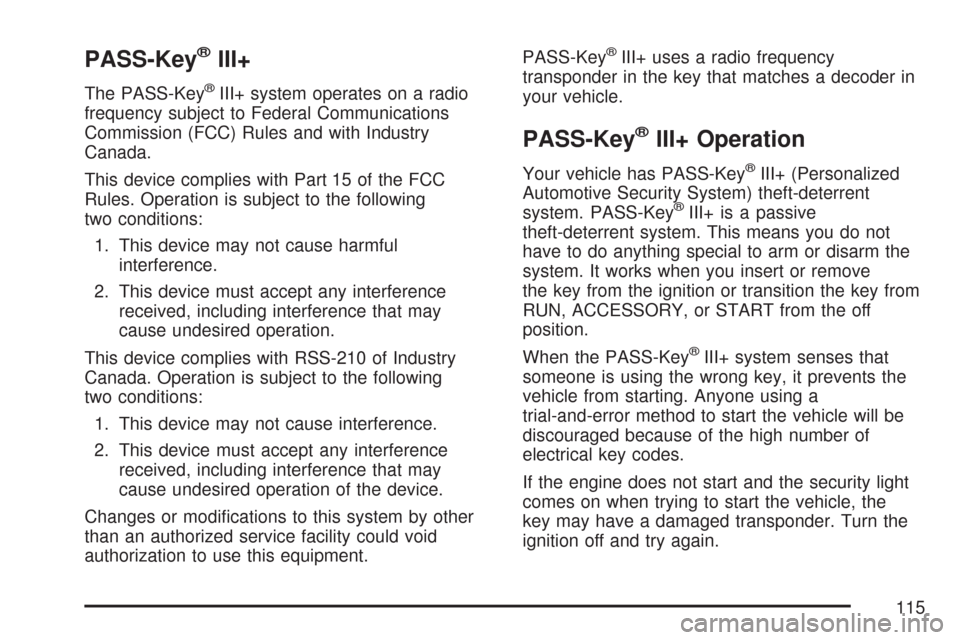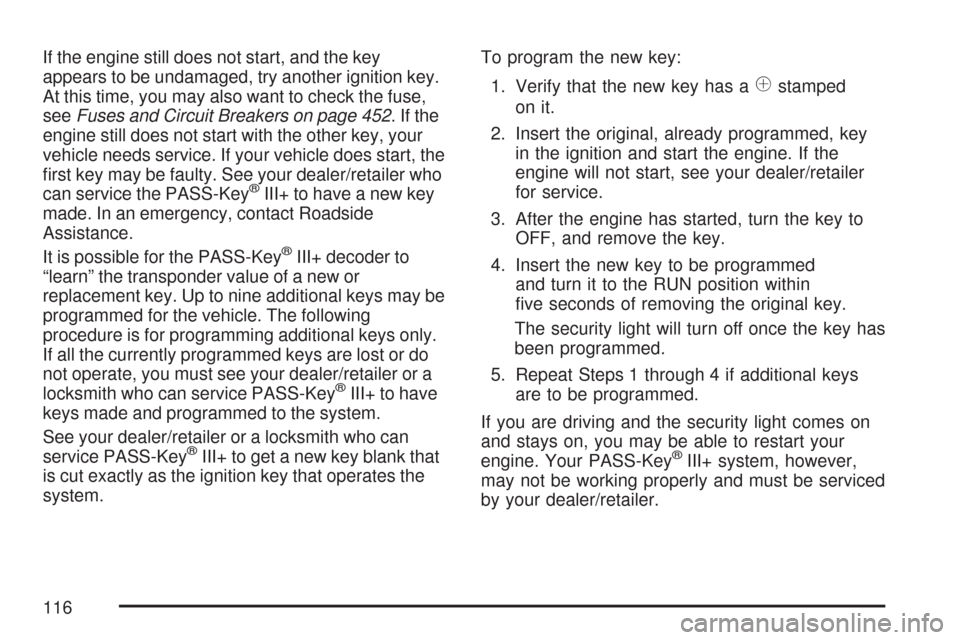CADILLAC DTS 2007 1.G Owners Manual
Manufacturer: CADILLAC, Model Year: 2007, Model line: DTS, Model: CADILLAC DTS 2007 1.GPages: 518, PDF Size: 2.77 MB
Page 111 of 518

The window will rise for as long as the switch is
held. Once the switch is released, the express
mode is re-activated.
In this mode, the window can still close on an
object in its path. Use care when using the
override mode.
Window Lockout
o
(Window Lockout):The rear window lockout
button is located on the driver’s door armrest
near the window switches.
Press the right side of the button to disable the
rear window controls. The light on the button
will illuminate, indicating the feature is in use. The
rear windows still can be raised or lowered
using the driver’s window switches when the
lockout feature is active.
To restore power to the rear windows, press the
button again. The light on the button will go out.
Sun Visors
Swing down the primary visor to block out glare. It
can also be detached from the center mount
and moved to the side while the auxiliary sunshade
remains to block the glare from the front. The
visors also have side-to-side slide capability.
Lighted Visor Vanity Mirror
Pull the visor down and lift the cover to view the
mirror. The light will come on when the cover
is opened. It will go out when you close the cover.
If your vehicle has the adjustable lighting feature,
slide the switch up or down to brighten or dim
the light.
111
Page 112 of 518

Rear Power Sunshade
If your vehicle has a rear power sunshade, it helps
to reduce the amount of heat and light entering the
rear window.
The switch is located on
the overhead console.
The rear power sunshade is located in the rear
shelf. It only works while the ignition is on or while
the Retained Accessory Power (RAP) is active. See
Retained Accessory Power (RAP) on page 119.
To raise the power sunshade, press and release
the switch. To close the power sunshade, press and
release the switch again.
Never store objects on the rear shelf because they
may get caught in the sunshade or be tossed
about in your vehicle.
Theft-Deterrent Systems
Vehicle theft is big business, especially in some
cities. Although your vehicle has a number of
theft-deterrent features, we know that nothing we
put on it can make it impossible to steal.
Valet Lockout Switch
The valet lockout switch
is located inside the
glove box.
112
Page 113 of 518

9(Off):Press this side of the button to turn the
lockout feature off. When the lockout feature is
off, you can open the trunk using either the keyless
entry transmitter or the trunk release button
located near the headlamp switch on the
instrument panel.
— (On):Press this side of the button to turn the
lockout feature on. When the lockout feature
is turned on, the trunk cannot be unlocked with
the keyless entry transmitter or the trunk release
button located near the headlamp switch on
the instrument panel.
If the valet lockout feature is on it will also disable
the Universal Home Remote transmitter, if
equipped.
Locking the glove box with your key will also help
to secure your vehicle.
SeeRemote Keyless Entry (RKE) System
Operation on page 96andTrunk on page 106for
additional information.Content Theft-Deterrent
The security light is
located on the
instrument panel cluster.
If the ignition is off and any door is open, the
security light will �ash, reminding you to arm the
system.
To arm the system:
1. Open the door.
2. Lock the door using the power door lock
switch with the door open or the Remote
Keyless Entry (RKE) transmitter. The security
light should come on and stay on.
3. Close all the doors. The security light should
go off within approximately 30 seconds.
If a door or the trunk is opened without a key or a
RKE transmitter, the horn will sound and the
lamps will �ash for about 30 seconds.
113
Page 114 of 518

The theft-deterrent system will not arm if you lock
the doors with a key or use the manual door
lock. It activates only if you use a power door lock
with the door open or the RKE transmitter.
To avoid activating the alarm by accident:
Lock the vehicle with the door key or the
manual door lock after the doors are closed.
Always unlock a door with a key or use the
RKE transmitter system. Pressing the unlock
button on the RKE transmitter disables
the theft-deterrent system. Unlocking a door
any other way will activate the alarm when
a door or the trunk is opened.
If you activate the alarm by accident, unlock the
driver’s door with your key. You can also turn
off the alarm by using the unlock button on
the RKE transmitter system, or by starting the car
with a valid key.
Changes or modi�cations made to this system by
other than an authorized service facility could
void authorization to use the theft system.
Testing the Alarm
1. From inside the vehicle, roll down the
window, then get out of the vehicle, keeping
the door open.
2. From outside of the vehicle, with the door
open, lock the vehicle using the power door
lock or the RKE system and close the
door. Wait 30 seconds until the security lamp
goes off.
3. Reach in and unlock the door using the
manual lock and open the door. The horn
will sound and the hazard lights will �ash.
You can turn off the alarm by unlocking the driver’s
door with your key, using the unlock button on
the RKE transmitter or by starting the car with a
valid key.
If the alarm does not sound when it should, check
to see if the horn works. The horn fuse may be
blown. To replace the fuse, seeFuses and Circuit
Breakers on page 452. If the fuse does not
need to be replaced, you may need to have your
vehicle serviced.
To reduce the possibility of theft, always arm the
theft-deterrent system when leaving your vehicle.
114
Page 115 of 518

PASS-Key®III+
The PASS-Key®III+ system operates on a radio
frequency subject to Federal Communications
Commission (FCC) Rules and with Industry
Canada.
This device complies with Part 15 of the FCC
Rules. Operation is subject to the following
two conditions:
1. This device may not cause harmful
interference.
2. This device must accept any interference
received, including interference that may
cause undesired operation.
This device complies with RSS-210 of Industry
Canada. Operation is subject to the following
two conditions:
1. This device may not cause interference.
2. This device must accept any interference
received, including interference that may
cause undesired operation of the device.
Changes or modi�cations to this system by other
than an authorized service facility could void
authorization to use this equipment.PASS-Key
®III+ uses a radio frequency
transponder in the key that matches a decoder in
your vehicle.
PASS-Key®III+ Operation
Your vehicle has PASS-Key®III+ (Personalized
Automotive Security System) theft-deterrent
system. PASS-Key
®III+ is a passive
theft-deterrent system. This means you do not
have to do anything special to arm or disarm the
system. It works when you insert or remove
the key from the ignition or transition the key from
RUN, ACCESSORY, or START from the off
position.
When the PASS-Key
®III+ system senses that
someone is using the wrong key, it prevents the
vehicle from starting. Anyone using a
trial-and-error method to start the vehicle will be
discouraged because of the high number of
electrical key codes.
If the engine does not start and the security light
comes on when trying to start the vehicle, the
key may have a damaged transponder. Turn the
ignition off and try again.
115
Page 116 of 518

If the engine still does not start, and the key
appears to be undamaged, try another ignition key.
At this time, you may also want to check the fuse,
seeFuses and Circuit Breakers on page 452.Ifthe
engine still does not start with the other key, your
vehicle needs service. If your vehicle does start, the
�rst key may be faulty. See your dealer/retailer who
can service the PASS-Key
®III+ to have a new key
made. In an emergency, contact Roadside
Assistance.
It is possible for the PASS-Key
®III+ decoder to
“learn” the transponder value of a new or
replacement key. Up to nine additional keys may be
programmed for the vehicle. The following
procedure is for programming additional keys only.
If all the currently programmed keys are lost or do
not operate, you must see your dealer/retailer or a
locksmith who can service PASS-Key
®III+ to have
keys made and programmed to the system.
See your dealer/retailer or a locksmith who can
service PASS-Key
®III+ to get a new key blank that
is cut exactly as the ignition key that operates the
system.To program the new key:
1. Verify that the new key has a
1stamped
on it.
2. Insert the original, already programmed, key
in the ignition and start the engine. If the
engine will not start, see your dealer/retailer
for service.
3. After the engine has started, turn the key to
OFF, and remove the key.
4. Insert the new key to be programmed
and turn it to the RUN position within
�ve seconds of removing the original key.
The security light will turn off once the key has
been programmed.
5. Repeat Steps 1 through 4 if additional keys
are to be programmed.
If you are driving and the security light comes on
and stays on, you may be able to restart your
engine. Your PASS-Key
®III+ system, however,
may not be working properly and must be serviced
by your dealer/retailer.
116
Page 117 of 518

If you lose or damage your PASS-Key®III+ key,
see your dealer/retailer or a locksmith who can
service PASS-Key
®III+ to have a new key made.
Do not leave the key or device that disarms or
deactivates the theft deterrent system in the
vehicle.
Starting and Operating Your
Vehicle
New Vehicle Break-In
Notice:Your vehicle does not need an
elaborate break-in. But it will perform better in
the long run if you follow these guidelines:
Do not drive at any one constant speed,
fast or slow, for the �rst 500 miles
(805 km). Do not make full-throttle starts.
Avoid downshifting to brake, or slow,
the vehicle.
Avoid making hard stops for the �rst
200 miles (322 km) or so. During this time
the new brake linings are not yet broken
in. Hard stops with new linings can
mean premature wear and earlier
replacement. Follow this breaking-in
guideline every time you get new brake
linings.
Do not tow a trailer during break-in. See
Towing a Trailer on page 342for the
trailer towing capabilities of your vehicle
and more information.
Following break-in, engine speed and load can
be gradually increased.
117
Page 118 of 518

Ignition Positions
With the ignition key in the ignition, the key can be
turned to four different positions:
Notice:Using a tool to force the key from the
ignition switch could cause damage or
break the key. Use the correct key and turn the
key only with your hand. Make sure the key
is in all the way. If none of this works,
then your vehicle needs service.A (OFF):This is the only position in which the
ignition key can be inserted or removed. This
position locks the ignition and transaxle. It is a
theft-deterrent feature.
B (ACCESSORY):This position lets the radio and
windshield wipers operate while the engine is
off. To use ACCESSORY, turn the key clockwise.
C (RUN):This position is where the key returns
to after the vehicle is started. This position displays
some of the warning and indicator lights.
The battery could be drained if you leave the key
in the ACCESSORY or RUN position with the
engine off. You may not be able to start your
vehicle if the battery is allowed to drain for
an extended period of time.
D (START):This position starts the engine.
A warning chime will sound and the Driver
Information Center (DIC) will display DRIVER
DOOR OPEN when the driver’s door is opened if
the ignition is in OFF, ACCESSORY and the
key is in the ignition. SeeDIC Warnings
and Messages on page 246for more information.
118
Page 119 of 518

Key In the Ignition
Never leave your vehicle with the keys inside, as it
is an easy target for joy riders or thieves. If you
leave the key in the ignition and park your vehicle,
a chime will sound, when you open the driver’s
door. Always remember to remove your key from
the ignition and take it with you. This will lock
your ignition and transaxle. Also, always remember
to lock the doors.
The battery could be drained if you leave the key
in the ignition while your vehicle is parked.
You may not be able to start your vehicle after it
has been parked for an extended period of time.
Retained Accessory Power (RAP)
These vehicle accessories can be used for up to
10 minutes after the ignition key is turned off:
Audio System
Audio Steering Wheel Controls
Power Windows
SunroofPower to these accessories will work up to
10 minutes or until the driver’s door is opened. For
an additional 10 minutes of power, close all the
doors and turn the key to RUN and then back
to OFF.
Starting the Engine
Place the transaxle in the proper gear.
Move your shift lever to PARK (P) or
NEUTRAL (N). Your engine will not start in
any other position – this is a safety feature. To
restart when you are already moving, use
NEUTRAL (N) only.
Notice:Shifting into PARK (P) with the vehicle
moving could damage the transaxle. Shift into
PARK (P) only when your vehicle is stopped.
Starting Procedure
1. With your foot off the accelerator pedal, turn
the ignition key to START. When the engine
starts, let go of the key. The idle speed will go
down as your engine gets warm. Do not
race the engine immediately after starting it.
119
Page 120 of 518

Operate the engine and transaxle gently to
allow the oil to warm up and lubricate all
moving parts.
Your vehicle has a Computer-Controlled
Cranking System. This feature assists
in starting the engine and protects
components. If the ignition key is turned to the
START position, and then released when
the engine begins cranking, the engine
will continue cranking for a few seconds or
until the vehicle starts. If the engine does not
start and the key is held in START for
many seconds, cranking will be stopped after
15 seconds to prevent cranking motor
damage. To prevent gear damage, this system
also prevents cranking if the engine is
already running. Engine cranking can be
stopped by turning the ignition switch to the
ACCESSORY or OFF position.
Notice:Cranking the engine for long periods
of time, by returning the key to the START
position immediately after cranking has ended,
can overheat and damage the cranking
motor, and drain the battery. Wait at least
15 seconds between each try, to allow
the cranking motor to cool down.2. If the engine does not start after 5-10 seconds,
especially in very cold weather (below 0°F or
−18°C), it could be �ooded with too much
gasoline. Try pushing the accelerator pedal all
the way to the �oor and holding it there as
you hold the key in START for up to a
maximum of 15 seconds. Wait at least
15 seconds between each try, to allow the
cranking motor to cool down. When the engine
starts, let go of the key and accelerator. If
the vehicle starts brie�y but then stops again,
do the same thing. This clears the extra
gasoline from the engine. Do not race the
engine immediately after starting it. Operate
the engine and transaxle gently until the
oil warms up and lubricates all moving parts.
Notice:Your engine is designed to work with
the electronics in your vehicle. If you add
electrical parts or accessories, you could
change the way the engine operates. Before
adding electrical equipment, check with
your dealer. If you do not, your engine might
not perform properly. Any resulting damage
would not be covered by your vehicle’s
warranty.
120